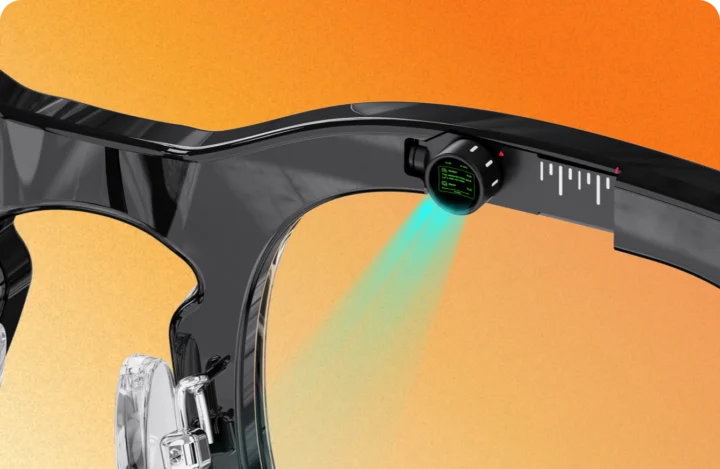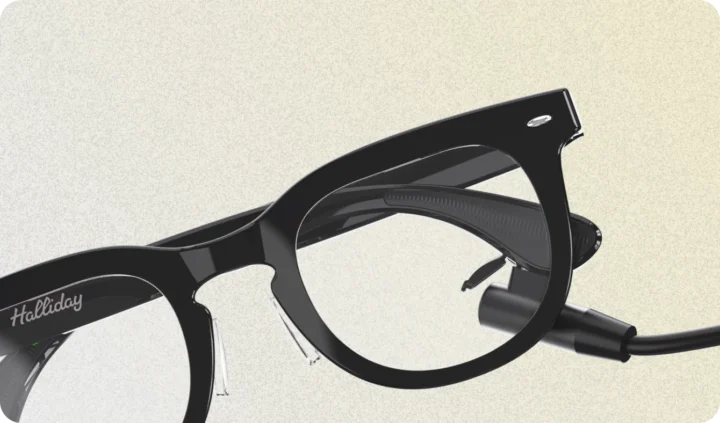Like the wearable voice-activated assistants last year (Rabbit R1 and Humane AI), smart glasses have become quite trendy and will likely be the most popular AI-enabled form factor this year. The Halliday smart glasses are a pair of AI-enabled smart glasses with an invisible display and a proactive assistant that “helps before you ask”.
The Halliday smart glasses integrate a small display module into the frame, unlike the Loomos and Looktech smart glasses launched earlier this year through crowdfunding campaigns. The display module, DigiWindow, is described as “the world’s smallest display module at 3.5mm” and invisible to onlookers. It uses a monochrome green MicroLED with projection optics to allow users to access information without obstructing their field of view.
The Halliday proactive AI smart glasses come in a lightweight frame, weighing only 35 grams. They can be controlled by voice, the included controller ring, a rapid button for shortcuts, or via a touch-sensitive panel on the glasses. There is no camera included, though. The CEO, Ran Ci, says this decision was made for privacy and battery life reasons. The battery is reported to last for more than 12 hours of normal use and 8 hours of continuous use with a 45 to 60-minute charge at the end of the day.
The “proactive” AI assistant, as the name implies, works behind the scenes and can “chime in your conversation and offer assistance based on the context.” Halliday also offers a cheat sheet feature (which could come in handy for live presentation notes), real-time language translation, and audio memo summaries. It can also play music, display notifications, and provide directions.

Unfortunately, there is very little information about the hardware in the glasses. The DigiWindow display module is sourced from AI-enabled wearable tech company, Gyges Labs and it can be adjusted for optimal viewing. It reportedly accommodates prescription adjustments from -8.0 to +2.0. The glasses require pairing with a smartphone to function and the companion app is available on iOS and Android devices.
The Halliday proactive AI smart glasses are available for pre-order through the Kickstarter campaign. They are priced at $399 for early backers with a standard retail price of $489. The bundle includes free prescription lenses, a companion control ring and charging adapter, a glasses case, a manual, a cleaning cloth, and a USB-C charging cable. The glasses are compatible with standard prescription lenses. Shipping is slated to commence by April 2025.
The Halliday FAQ document may more information about the product and the company’s policies.

Tomisin is a writer specializing in hardware product reviews, comparisons, and explainers. He is very passionate about small form factor and single-board computers.
Support CNX Software! Donate via cryptocurrencies, become a Patron on Patreon, or purchase goods on Amazon or Aliexpress






$39.99 and I’m in for the short term gimmickry.
Helping before I ask would become infuriating.
I think I’ll wait for reviews before ordering…
The worst scam promo video ever?
Yes, makes me say no way.
[ Is it possible to focus on a display within that distance?
Google glass had a longer distance to the display lenses, AFAI_remember?
There are patents for rings being an input device.
Is it an (next gen) AI video? ]
[ but maybe more important, “no aliens were harmed during the production of this video” 🙂
“display offers a field of view akin to a 3.5-inch screen” and ring control input device,
nice ideas, from my POV
(let’s see if it’s a product) ]
So if I understand this correctly, this is just a tiny monochrome display connected via BLE to an app running on a smartphone, which is the one actually doing any work (with the help of the cloud of course)? Other than a few buttons/sliders on the glasses and ring, there does not seem to be much else, I don’t even think there’s a microphone or speakers.
While this is probably a better idea than the Humane AI fail, I’m not sure there are that many use cases where looking up at the top rim of your glasses and clicking on your ring is actually more practical than just using your phone. You won’t even be able to use it to pretend you’re not using your phone as the upwards glances will be quite visible.